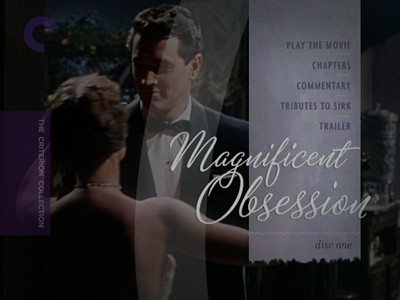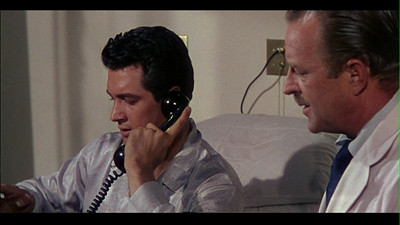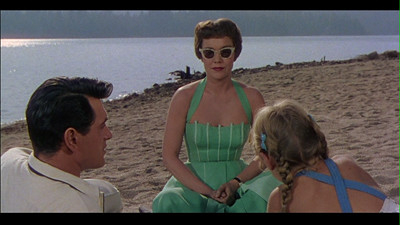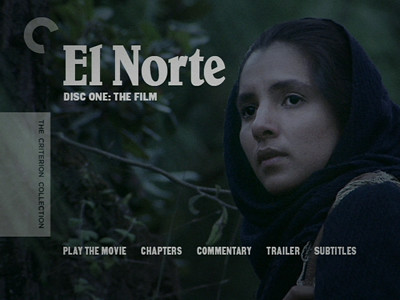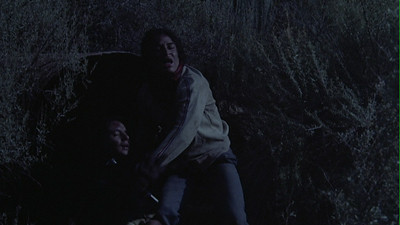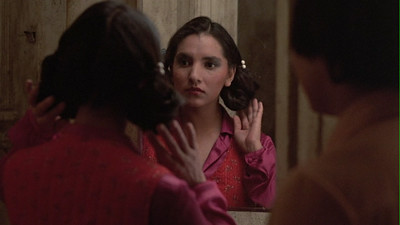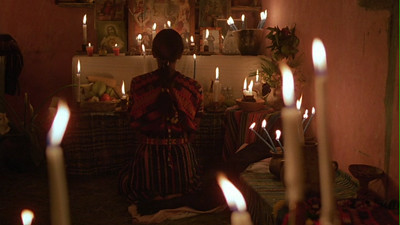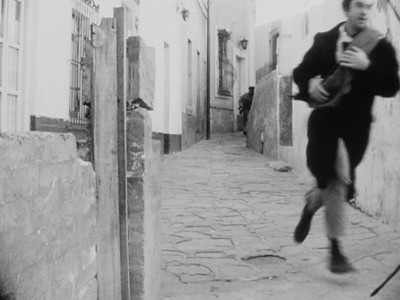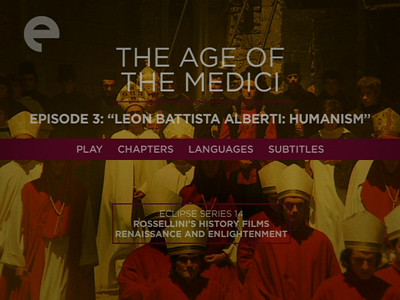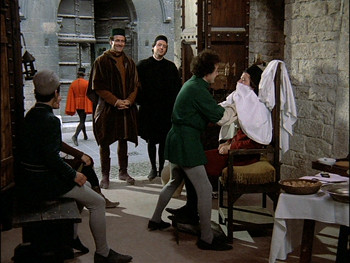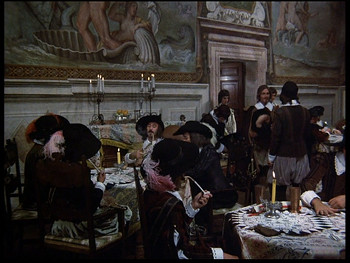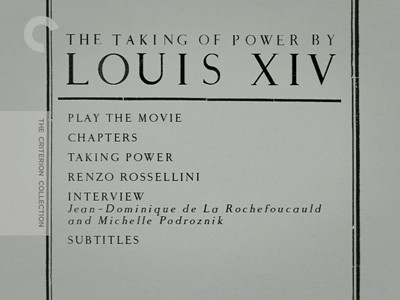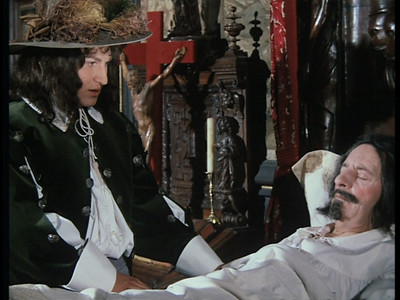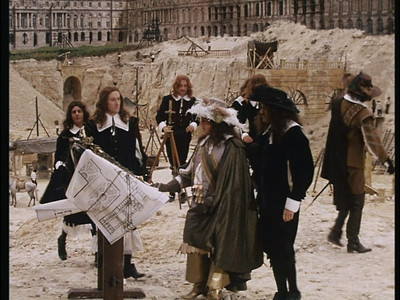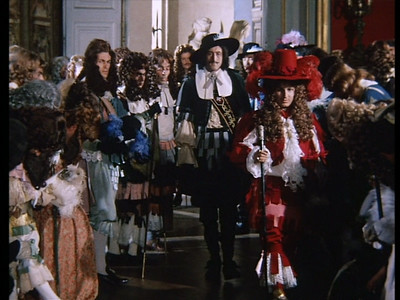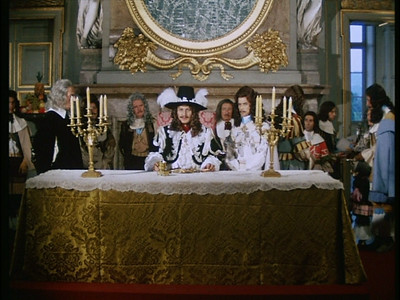
A small sailboat becomes the center of male competition in Roman Polanski's tense 1962 debut, Knife in the Water. When a middle-aged Polish couple heads out for a Sunday on the water, they nearly crash their car trying to avoid a hitchhiker (Zygmunt Malanowicz) whose technique for flagging down rides is to stand in the middle of the road and play chicken with oncoming cars. At first angry, the husband, Andrzej (Leon Niemczyk), curses the nineteen-year-old; yet, he also senses his wife's attraction and sympathy for the boy, so to prove a point, he gives the hitcher a ride and then convinces him to go out on their trip with them.

From the get-go, Andrzej and the boy are at odds. The boy shows off his knife, and Andrzej shows off his boat, knowing the kid doesn't have the skills to handle it. The hitcher and his knife make claims to being tied to the land, where a man lives on his feet and by his hands, where a knife is necessary. A blade is ineffective against water, and Andrzej is convinced the open sea requires more skill and mental tenacity to navigate. It's philosophical and it requires tactical know-how, you can't just hack and slash your way through. He claims the mantle of skipper and orders the boy around. It's the battle of young and old, father and son, a clash of generations.
And yet it's totally childish. The men show off for one another, and what each one does, the other has to try. If Andrzej can captain the boat, the young man wants to do it, too. When the young man plays a game with his knife where he lays his hand flat, splays his fingers, and stabs the blade in between them, Andrzej sheepishly picks the weapon up when the boy is not looking and takes a crack at it himself. When the boy whistles, the older man shushes him, invoking a maritime superstition, but then whistles himself, either forgetting or having now been caught in a lie. When the hitcher makes fun of a tool Andrzej uses to hold a hot metal soup pot, Andrzej goads him into holding it with his bare hands.

One would think the two men are showing off for the benefit of Krystyna (Jolanta Umecka), Andrzej's wife and the woman after which the sailboat has been named. Half the time, though, it doesn't even look like they notice her. Even though it's taken for granted that she is the unnamed prize of this standoff, Polanski and his writers, Jerzy Skolimowski and Jakub Goldberg, understand that most masculine contests are contests of approval. In some way, the youngster wants dear old dad to think he's okay, while pops wants the kid to think he's cool. (Copying his whistling may be an unconscious attempt on Andrzej's part to appear youthful.) There is also a touch of the homoerotic when they play their knife game, with Andrzej submitting to let the other man work the blade through his fingers. Still, they never touch one another, and Polanski smartly withholds any real violence until it really matters; it's almost more pathetic when no one is getting punched in the nose.
Polanski is also sly enough to underplay Krystyna's role. Her reactions are few and far between, and they mostly are the result of exasperation that the boy doesn't know what to do and her husband won't just get it over with and tell him. From the first time we see Krystyna, however, Polanski locks us into a slow physical seduction. In the car, she has her hair up and wears pointed secretary classes. She is pretty, but she is holding back--not waiting to be unleashed like some sexy librarian stereotype, but instead waiting to reveal herself and her role in all of this. As soon as the group is on the water, Krystyna changes into a skimpy bikini. The male gaze is immediately drawn to her. The boy--and the viewer--is always aware of where she is, and Andrzej--along with, once again, the viewer--is always aware that he's aware. He catches every little look, including the boy sneaking a peek when she is changing, as well as noting every time Krystyna comes to the young man's defense.

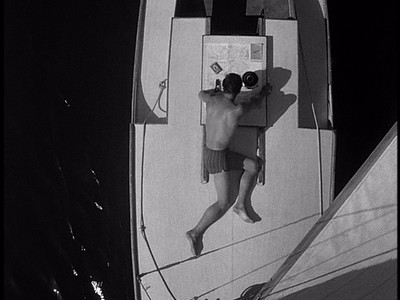
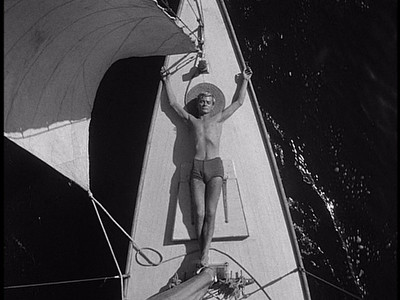
The dichotomy here is probably best represented in a scene down in the hull, where the three of them have retreated to wait out a rainstorm. They play pick-up sticks (or jackstraw, as it's called here), and every time someone loses, he or she has to forfeit some personal object. Krystyna gives up a shoe, the young man his belt and then his knife--prompting another contest, a phallocentric knife toss, which Krystyna stops after the boy's second throw, blocking her husband from getting a second try in the contest. She then asks what she must do to get her shoe back. The boy demands a song, an idea Andrzej shoots down. He'd rather listen to the boxing match on the radio. They compromise, and Andrzej puts on an earpiece. His wife sings with a girlish shyness, prompted by the boy, and then in return, he recites a poem for her to regain his belt. Her song is one of troubled love, his poem is about a young man's desires. For his part, Andrzej can only wonder aloud how he missed the announcement of the Polish middleweight champ getting defeated. "How did he get k.o.'d?" he asks, completely oblivious to the irony of the question. How did the inattentive husband get knocked out in his own boat?


If you consider that the boat is named for Krystyna, it's a none-to-subtle reinforcement of what the battle between the two men is over, and since it's the boat they rely on to get them home, also an indicator of who might be in control. By morning, Krystyna's transformation is complete. The once bundled-up woman now has her hair down, and she sits smoking on the deck, wearing only a long sweater that suggests she may have nothing on underneath (strangely, she's concealing a one-piece bathing suit, which is like the heftier twin of her bikini, a similar style and the same color). She has completely freed herself from the restraints of the land, she is fully sexualized, and it prompts a showdown.
Just as Krystyna finds a certain feminine freedom on the water (a fertility symbol, no less), so too are the men free now of the restraints of polite society. Though there is surprisingly little action in this climactic battle, it does call to mind the animal that was unleashed in Sam Bowden when he lead Max Cady out to sea for their final squaring off in both
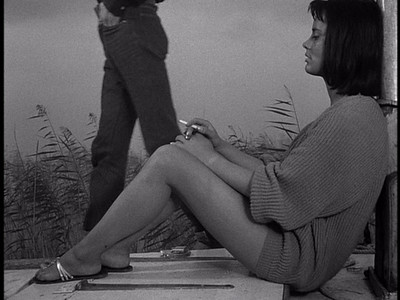
The choice to place Knife in the Water on a boat also has a visual significance that Polanski and his cinematographer, Jerzy Lipman, exploit to the fullest. The setting is its own contradiction: this trio has both everywhere to go and yet nowhere. On the boat, they are cramped, forced together, and Polanski frames them as such. At the same time, the world all around them is vast and open, and so he and Lipman can pull away to show their isolation on a grander scale. The travelers appear small against the vast sky, and the shore, along with the civilization it supports, far away, mere dots on the horizon. No one else is out there to see what they do to each other. A victim can't be saved, an aggressor won't be punished.
Though commonly classified as a thriller, Knife in the Water is less of a suspense film than it is a terse and cynical drama about marriage. The final scenes reveal what this has all been for. If the pick-up sticks game was the combination, the ending is the lock opening. Polanski chooses not to show us any decisions on the part of the couple, but rather to leave them stuck in between. Do they trust each other anymore? Did they ever? Has this all been a game to add a little spice to the stew? Or is this truly where two people bored with each other end up?

The second disc in the Knife in the Water Criterion set features eight of the short films Polanski made between 1957 and 1962. In them, you can see some of his obsessions and visual tics beginning to emerge. Early themes include crime, desire, and invasion. The earliest and shortest pieces, the completely soundless "Murder" and "Teeth Smile," show a single killing and a peeping tom, respectively. His first film with sound, "Break Up the Dance," features a staged prank where Polanski unleashes the town's delinquents on an unsuspecting school dance and films what happens when the outsiders make their way in. It's like his own initial assault on cinema. He even uses a figure diving into a fountain as the moment to cut the music and remove any pretense of good times at the gathering--water being integral to a lot of his films, including, of course, Knife in the Water and Chinatown
The titular two men and their wardrobe in "Two Men and a Wardrobe" actually emerge from the ocean carrying their little piece of furniture. It's a dark take on the classic comedic duo paradigm, the men wandering through the city oblivious to the human cruelty that goes on around them. That is, until the mirror their wardrobe holds up to life reflects the wrong image and the city folk turn against them. Unlike, say, Laurel and Hardy, these two don't win in the end, they retreat, the only sign that they maintain their compassion as they return to the drink is they manage not to crush any of the sand turrets a little boy has erected on the beach.

Just as the two men came out of the vast sea, so too did that film take Polanski out of Poland. From there, his films would become more experimental ("The Lamp") and expansive ("When Angels Fall" features an old woman ruminating on the life she's lived, though the film lacks an integrity of point-of-view and Polanski has her remember things she would not have witnessed). To extend the notion of some of these shorts as parables for Polanski and his film career, then we could also see "The Fat and the Lean," with its young man (played by Polanski himself) enslaved to a brutish, corpulent older fellow with the dazzling Parisian skyline always within eyeshot as the Polish filmmaker yearning for a more discerning film industry than his homeland provided. Though, obviously, the short is most likely intended as a political allegory about the abuses of power and the way people begin to accept that abuse as compassion.
The set of shorts ends on a playful note, with Polanski returning to the idea of a comedic duo. "Mammals" follows two bumblers traversing across a snowy landscape. Ostensibly a string of gags, much of its purpose appears to be in allowing the director to experiment with film stock and various effects (the one man's flickering suit is bizarre, almost like a mistake--was it?). Like most of the films here, it is a silent movie. All but two of these selections ("Break up the Dance" and "When Angels Fall") are shot as silent films with only music and sound effects. Polanski didn't think short subjects should have dialogue getting in the way of the storytelling. That's quite a challenge for a rookie filmmaker, but by "Angels" and "The Fat and the Lean," the confidence that would lead to Knife in the Water is firmly in place--and well earned.

Polanski in "The Fat and the Lean"
